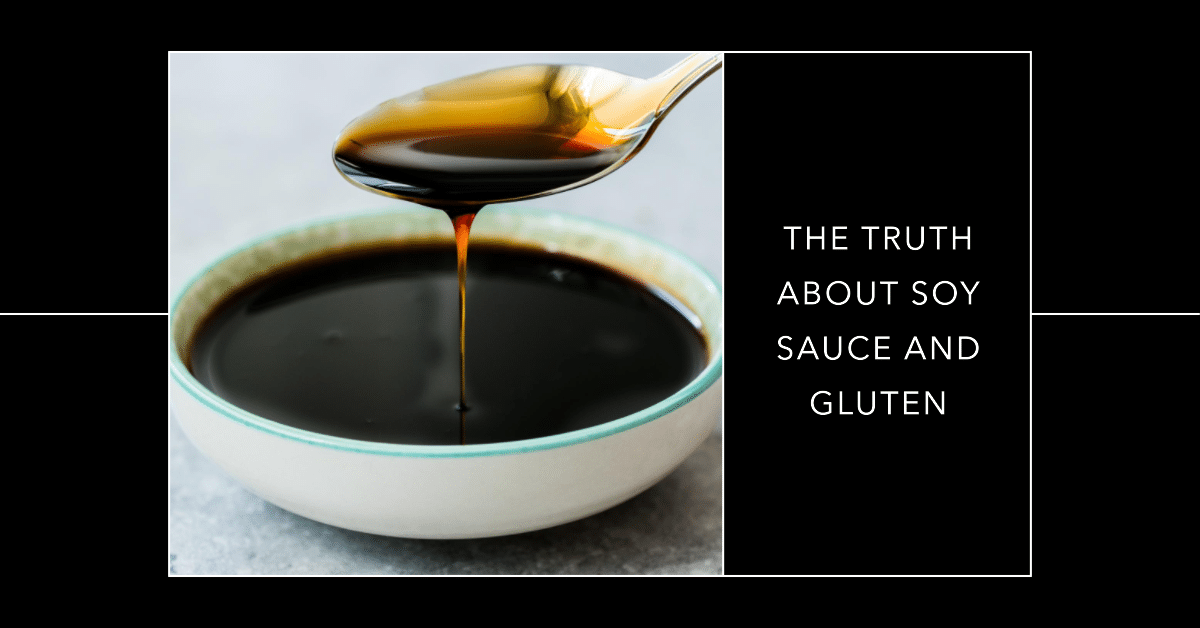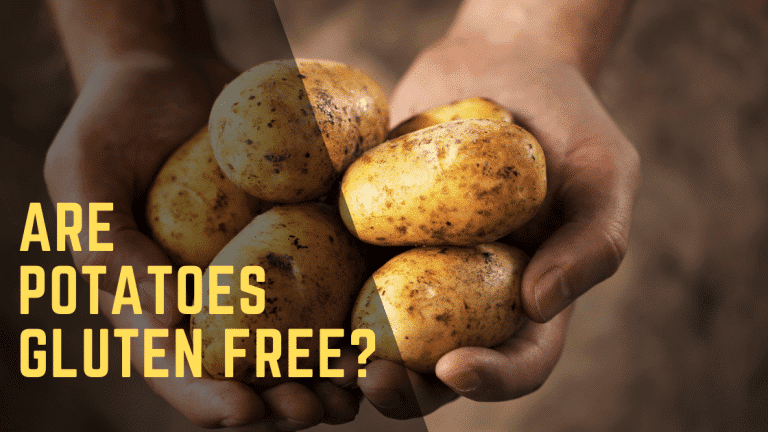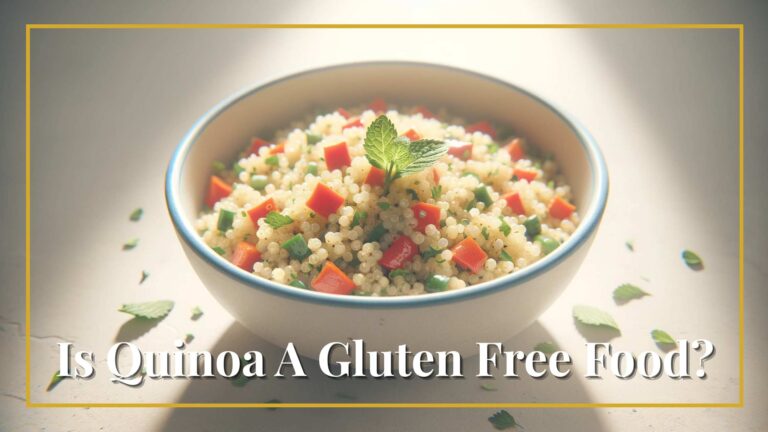Why Isn’t Soy Sauce Gluten-Free? The Hidden Wheaty Secret

Ever wondered – why isn’t soy sauce gluten-free?
The answer lies in its traditional brewing process. Soy sauce is made by fermenting soybeans and wheat, which contains gluten.
Soy sauce gets its distinctive taste this way, but it makes it unsuitable for those with gluten intolerance.
Join us as we explore the details behind soy sauce’s gluten content, providing insights into why it may pose a risk for individuals following a gluten-free diet.
Get ready to uncover the facts and understand why soy sauce remains off-limits for those with gluten sensitivity.
What Is Soy Sauce Made Of?
Picture this: soy sauce, the flavor powerhouse of Asian cuisines. It’s made by fermenting soybeans, wheat, and other delightful ingredients.
Now, here’s the catch: standard soy sauce isn’t gluten-free.
Why? Well, that mischievous gluten lurks in the wheat, making it a no-go for those on a gluten-free journey. So, if you’re avoiding gluten like the plague, be cautious when reaching for that bottle of soy sauce.
But fear not! There are gluten-free alternatives out there that can still give your taste buds a wild ride.
Stay true to your gluten-free path and explore the world of condiments with confidence!
Are There Gluten-Free Soy Sauces?
Yes, there are a few options for gluten-free alternatives to soy sauce.
- Tamari – This is made with just soybeans and salt, without any wheat. Make sure to verify the label, as some tamari contains a small amount of wheat.
- Coconut aminos – Sauces made from fermented coconut palm sap can replace soy sauce in recipes. They have an umami flavor similar to soy.
- Liquid aminos – These sauces are made by fermenting just soybeans without grains. They are wheat and gluten-free.
- Shoyu – Some versions of this form of soy sauce are made with rice instead of wheat. These are called “shoyu” on the label.
Double check the ingredients list when purchasing any of these alternative soy sauces.
Avoid ones containing wheat, barley, rye, malt or other gluten sources.
Does All Soy Sauce Have Gluten?
In most cases, yes, soy sauce does contain gluten.
Here are some key points on the gluten content of different types of soy sauce:
- Traditional soy sauce is made with both soy and wheat, so it contains gluten. This includes Chinese and Japanese soy sauces.
- Tamari may be labeled “gluten-free” but still contain traces of gluten from wheat. Check for certified gluten-free labels to be safe.
- “Shoyu” soy sauce contains wheat unless specifically labeled as “gluten-free shoyu soy sauce”.
- Worcestershire sauce often contains wheat, barley or malt vinegar. Check labels carefully for gluten-free versions.
- Kikkoman Soy Sauce contains wheat and barley, so it is not gluten-free (unless you get their GF-labeled version!)
Unless a soy sauce is certified gluten-free, it likely contains at least traces of gluten from ingredients like wheat.
People with celiac disease or gluten sensitivity should avoid soy sauce unless they can verify it is 100% gluten-free.
What About Fermented Soy Sauce?
There are two main methods of producing soy sauce:
- Brewed – Made faster by mixing wheat and soy. Contains gluten.
- Fermented – Traditional method without wheat, using soy beans and salt. Gluten-free.
So you may see “fermented soy sauce” on some labels. This indicates a potentially gluten-free soy sauce made by slowly fermenting just soybeans and salt, without adding wheat.
However, the fermentation label alone doesn’t guarantee the sauce is gluten-free.
Check for certification or contact the manufacturer to confirm no wheat, barley or rye are used in their fermented soy sauce.
Choosing a Gluten-Free Soy Sauce
When shopping for soy sauce, read labels carefully to avoid those containing wheat, barley, rye or malt ingredients. Here are some tips for choosing a gluten-free soy sauce:
- Look for soy sauces certified gluten-free by an organization like GFCO. This ensures thorough testing and compliance with labeling laws.
- Tamari is typically gluten-free, but confirm the label doesn’t list wheat as an ingredient.
- Purchase reputable brands labeled “gluten-free” like San-J or Kari-Out soy sauce.
- Call or email manufacturers if you have any concerns about ingredients containing hidden gluten.
- Compare soy sauce products and brands online to identify gluten-free options based on ingredient lists.
- Stick to liquid aminos and coconut aminos to avoid the uncertainty around soy sauce.
Following a gluten-free diet requires diligence reading labels and researching products.
When in doubt, reach out to manufacturers directly to inquire about their production methods and gluten testing.
Also Read: How To Know if Something Is Gluten-Free
Why Is Soy Sauce Not Gluten-Free? – Final Thoughts
While delicious, soy sauce often contains gluten from wheat. Traditional soy sauce is made by fermenting a blend of soybeans and wheat.
The wheat contributes flavor and texture, but also adds gluten. There will be gluten in soy sauce unless specifically produced without wheat or other gluten grains.
Fortunately, there are a few gluten-free soy sauce alternatives available like tamari and liquid aminos.
When buying soy sauce, always read the label carefully to check for wheat, barley, rye and malt ingredients.
Otherwise, look for certified gluten-free labels to ensure the soy sauce does not contain traces of gluten.
With so many options now available, people following gluten-free diets can still safely consume soy sauce.
Just be diligent in verifying the ingredients before using soy sauce to avoid unwanted gluten.
Related Article: Can A Celiac Have Soy?
Soy Sauce On A Gluten-Free Diet – FAQs
Can I use regular soy sauce on a gluten free diet?
No, regular soy sauce contains wheat and barley which means it is not gluten-free. Always opt for a gluten-free certified tamari soy sauce instead of regular soy sauce.
Is tamari soy sauce gluten-free?
Yes, tamari is a gluten-free alternative to regular soy sauce. However, always check the label to confirm the tamari is certified gluten-free, as some tamari contains a small amount of wheat.
What can I use instead of soy sauce on a gluten-free diet?
There are a few good soy sauce substitutes for gluten-free diets including tamari, liquid aminos, coconut aminos, or gluten-free shoyu soy sauce. Worcestershire sauce and oyster sauce also typically contain gluten.
Does soy sauce have gluten?
Yes, regular soy sauce contains wheat which means it has gluten. Only specially labeled “gluten-free” soy sauces do not contain gluten. Tamari, liquid aminos, and coconut aminos are naturally gluten-free alternatives.
Is my gluten-free diet compromised if I accidentally ingest soy sauce?
Yes, even tiny amounts of gluten can cause issues for those with celiac disease or gluten sensitivity. It’s best to avoid soy sauce unless it is certified gluten-free.
Disclaimer: This content is based on my personal experience as an individual diagnosed with celiac disease and IBS (Irritable Bowel Syndrome) who follows a strict gluten-free diet. This does not constitute medical advice. Please consult a medical professional, nutritionist, or qualified dietitian for personalized, professional advice.






